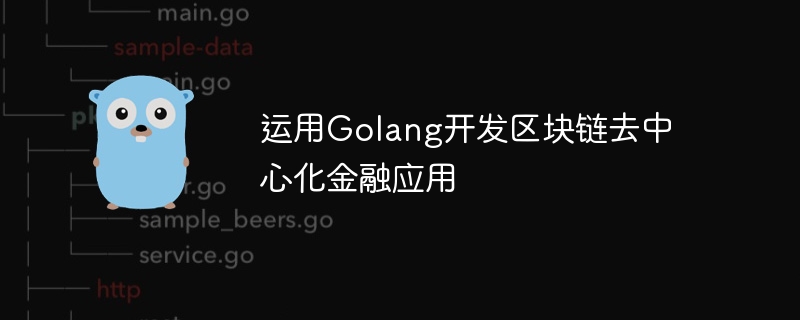
The Go programming language is ideal for building DeFi applications as it allows users to write smart contracts, interact with the blockchain, and create tokens. Smart contracts can be used to define rules and logic, libraries and tools can be used to interact with the blockchain, and practical examples provide examples of creating tokens that allow users to mint, transfer and check balances.

Using Go to build blockchain decentralized finance (DeFi) applications
Introduction
The development of blockchain technology has promoted the rise of the field of decentralized finance (DeFi). DeFi applications allow users to conduct various financial transactions without relying on traditional financial institutions. Go is a powerful, efficient, and easy-to-use programming language that is ideal for developing DeFi applications.
Creating Smart Contracts
Smart contracts are self-executing pieces of code stored on the blockchain. They can be used to define the rules and logic of DeFi applications. Here is a simple smart contract example written in Go:
package main
import (
"fmt"
)
type Asset struct {
Name string
Value float64
}
func main() {
asset := Asset{
Name: "MyAsset",
Value: 100.0,
}
fmt.Printf("Asset Name: %s\n", asset.Name)
fmt.Printf("Asset Value: %f\n", asset.Value)
}Interacting with the Blockchain
Once the smart contract is deployed, you can use libraries in Go and Tools interact with the blockchain. For example, you can use the Ethereum client library to connect to the Ethereum network and interact with contracts:
package main
import (
"context"
"fmt"
"github.com/ethereum/go-ethereum/client"
"github.com/ethereum/go-ethereum/common"
"github.com/ethereum/go-ethereum/ethclient"
)
func main() {
// 连接到以太坊网络
client, err := client.Dial("ws://localhost:8546")
if err != nil {
panic(err)
}
defer client.Close()
// 加载智能合约 ABI
contractAddress := common.HexToAddress("0x1234...")
bytecode, err := client.CodeAt(context.Background(), contractAddress, nil) // 从链上获取已部署的合约bytecode
if err != nil {
panic(err)
}
// 创建与合约交互的函数
contract, err := ethclient.NewContract(contractAddress, bytecode)
if err != nil {
panic(err)
}
// 调用智能合约函数
result, err := contract.Call(context.Background(), "balanceOf", common.HexToAddress("0xabcd...")) // 注意此处传入函数名及其参数
if err != nil {
panic(err)
}
fmt.Println(result)
}Practical case: Token creation
The following is an example created using Go Practical example of tokens:
// 定义代币合约
type Token struct {
Name string
Symbol string
TotalSupply int64
Balances map[string]int64
}
// 创建代币
func NewToken(name, symbol string, totalSupply int64) *Token {
return &Token{
Name: name,
Symbol: symbol,
TotalSupply: totalSupply,
Balances: make(map[string]int64),
}
}
// 分发代币
func (token *Token) Distribute(recipient string, amount int64) {
token.Balances[recipient] += amount
}
// 转移代币
func (token *Token) Transfer(sender, recipient string, amount int64) {
token.Balances[sender] -= amount
token.Balances[recipient] += amount
}
// 主函数
func main() {
// 创建代币
token := NewToken("MyToken", "MTK", 1000000)
// 分发代币
token.Distribute("Alice", 500000)
token.Distribute("Bob", 300000)
token.Distribute("Carol", 200000)
// 转移代币
token.Transfer("Alice", "Bob", 100000)
// 输出余额
fmt.Println("Alice's Balance:", token.Balances["Alice"])
fmt.Println("Bob's Balance:", token.Balances["Bob"])
fmt.Println("Carol's Balance:", token.Balances["Carol"])
}This Go program creates an ERC-20 compatible token named "MyToken". It allows users to mint, transfer and check balances.
The above is the detailed content of Using Golang to develop blockchain decentralized financial applications. For more information, please follow other related articles on the PHP Chinese website!




